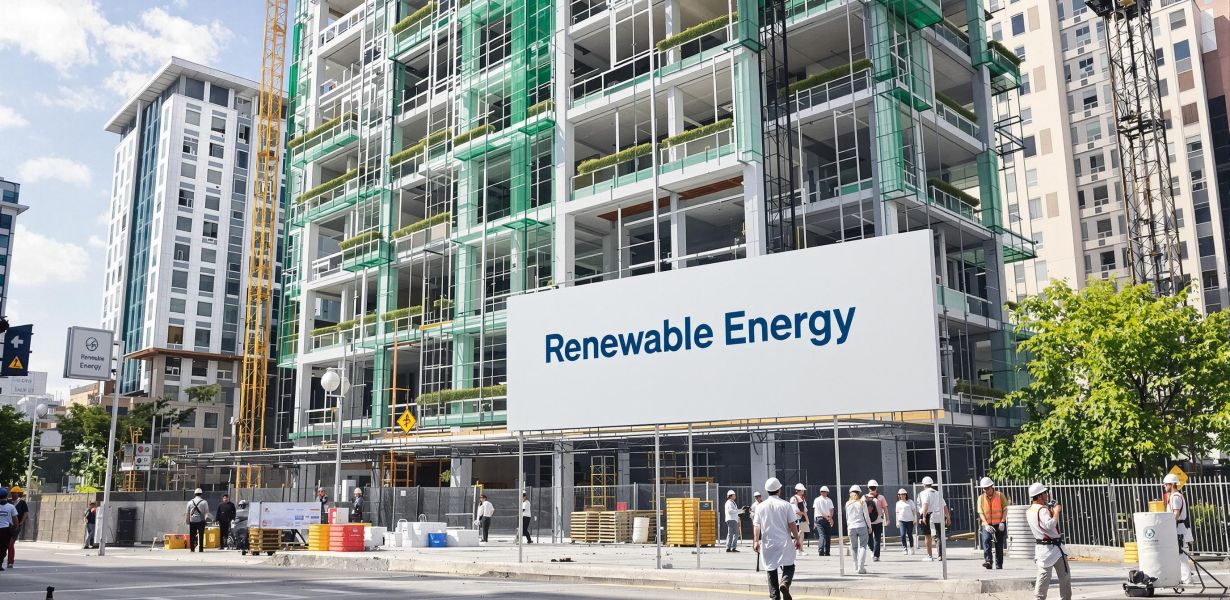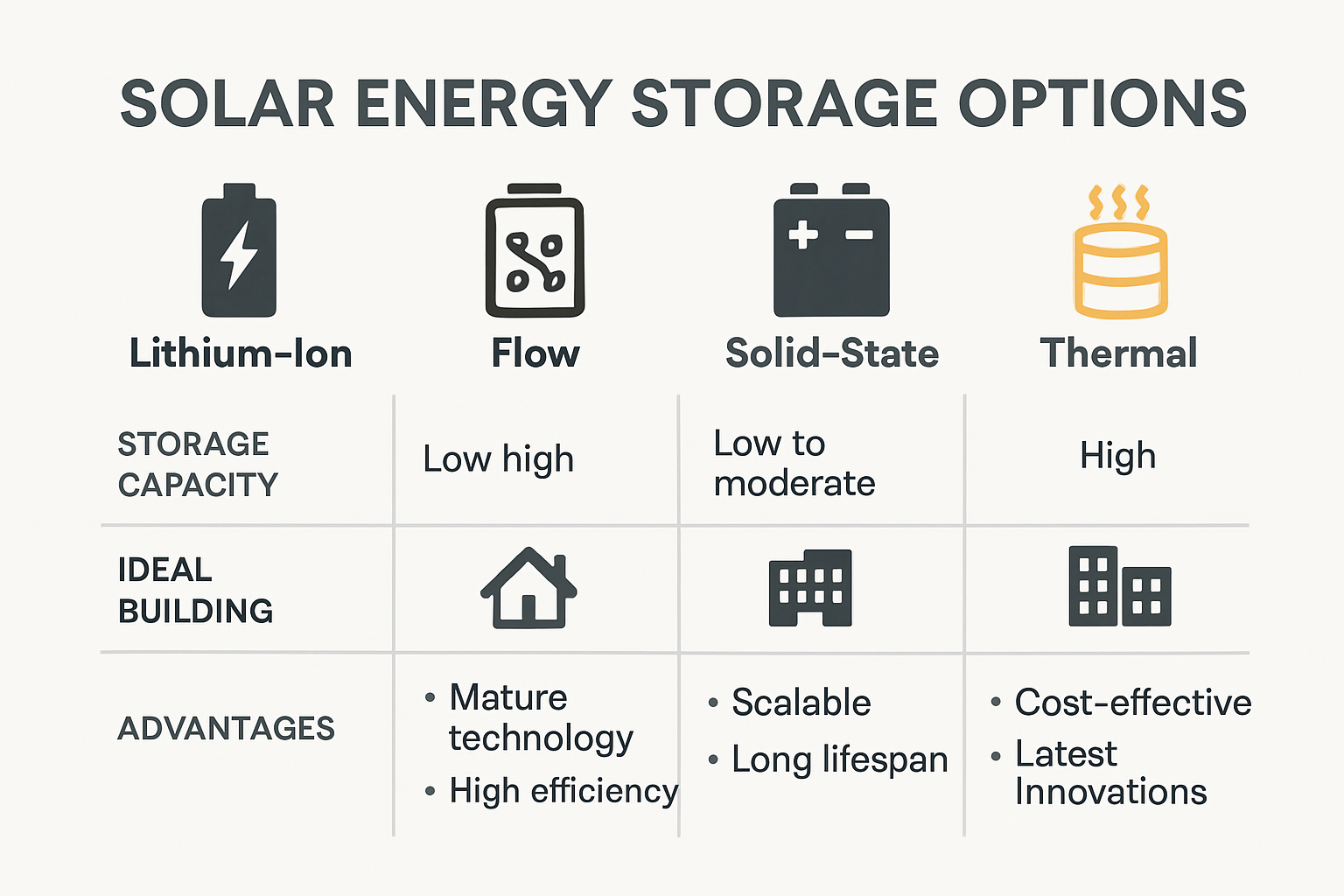
July 15, 2025
Onyx Solar USA
79 Madison Avenue, Ste. #231
New York, NY 10016
usa@onyxsolar.com
+1 917 261 4783
Onyx Solar Spain
Calle Río Cea 1, 46,
05004 Ávila. Spain.
info@onyxsolar.com
+34 920 21 00 50

Solar energy is changing the way buildings use power, and industry leaders are racing to keep up. Here is something that might surprise you. Battery storage capacity has grown from under 2,000 megawatts in 2020 to nearly 30,000 megawatts by April 2025. Most people expect battery breakthroughs to be the whole story, but the real advantage is now in how smart systems and tailored designs are transforming storage for every building type. Look closer and you will find that the next wave of solar energy storage is about much more than just the batteries.
| Takeaway | Explanation |
|---|---|
| Advanced Battery Technologies Are Essential | Modern solar energy storage primarily relies on lithium-ion batteries and emerging technologies like flow and solid-state batteries, crucial for effective energy preservation and distribution. |
| Tailored Solutions for Different Building Types | Solar energy storage solutions need to be customized for residential, commercial, and specialized buildings, taking into account unique energy requirements and architectural designs. |
| Integration with Energy Management Systems is Key | Incorporating sophisticated energy management technologies enhances the efficiency and reliability of solar storage solutions by optimizing power distribution and consumption patterns. |
| Importance of Regulatory Compliance | Building professionals must navigate various regulatory standards and interconnection requirements to ensure safe and compliant integration of solar energy storage systems. |
| Future Innovations Will Transform Energy Storage | Advances in technology, including AI-driven systems and solid-state batteries, are set to revolutionize solar energy storage, making it more efficient and adaptable for future needs. |
Solar energy storage represents a critical technological frontier for building professionals seeking sustainable and resilient energy solutions. As renewable energy systems become increasingly sophisticated, understanding the nuanced options for storing solar-generated electricity has transformed from a niche consideration to a fundamental design strategy.

Modern solar energy storage primarily relies on advanced battery technologies that capture and retain electrical energy generated by photovoltaic systems. The U.S. Department of Energy has strategically invested $325 million to advance long-duration battery technologies capable of storing renewable energy for extended periods, signaling the critical importance of this technological domain.
Lithium-ion batteries currently dominate the market, offering high energy density and relatively quick charging capabilities. These batteries enable building professionals to store excess solar energy generated during peak sunlight hours and redistribute it during periods of low solar generation. Recent innovations have significantly improved their storage capacity, efficiency, and overall lifespan.
Alternative battery technologies are also emerging, including flow batteries and solid-state batteries. Flow batteries, for instance, provide unique advantages in large-scale storage applications, with the ability to decouple power capacity from energy storage capacity. This characteristic makes them particularly attractive for commercial and institutional building projects requiring flexible energy management solutions.
Effective solar energy storage goes beyond simply collecting and preserving electrical energy. Modern systems incorporate sophisticated energy management technologies that optimize power distribution, monitor consumption patterns, and intelligently balance supply and demand.
According to research published in Energy Nexus, integrating renewable energy systems with diverse storage technologies enhances grid reliability and sustainability. These advanced systems can automatically switch between stored solar energy and grid power, ensuring uninterrupted electrical supply while maximizing cost-efficiency.
Smart inverters and digital management platforms play a crucial role in this process, providing real-time monitoring, predictive maintenance capabilities, and granular control over energy flows. Building professionals can now implement storage solutions that not only preserve solar energy but also actively optimize its utilization across complex infrastructural environments.

The solar energy storage landscape continues to evolve rapidly. Cutting-edge research from the Proceedings of the National Academy of Sciences suggests that combined solar photovoltaic systems with advanced storage technologies can provide cost-competitive electricity solutions, particularly in regions committed to achieving carbon-neutral energy infrastructures.
Emerging technologies such as thermal energy storage, hydrogen-based systems, and artificial intelligence-driven prediction models are expanding the boundaries of what is possible in solar energy preservation. These innovations promise to make solar storage more efficient, adaptable, and integrated with broader urban energy ecosystems.
For building professionals, staying informed about these technological developments is not just beneficial—it is essential. The future of sustainable architecture lies in our ability to capture, store, and intelligently manage renewable energy resources.
Solar energy storage technologies are not universal solutions but rather specialized systems tailored to specific building types, architectural configurations, and energy requirements. Building professionals must strategically select storage technologies that align with their project’s unique characteristics, performance goals, and sustainability objectives.
Residential buildings demand flexible and compact solar energy storage systems that can adapt to varying household energy consumption patterns. Hybrid photovoltaic-thermal (PVT) systems offer an innovative approach by simultaneously generating electricity and thermal energy, making them particularly efficient for homes with diverse energy needs.
Lithium-ion battery systems remain the most popular residential storage technology, offering compact design, high energy density, and relatively low maintenance requirements. These systems typically range from 5 to 15 kilowatt-hour (kWh) capacities, suitable for managing daily household electricity demands and providing backup power during grid interruptions.
Interesting emerging technologies like home-scale solid-state batteries promise enhanced safety and longer operational lifespans compared to traditional lithium-ion solutions. These advancements suggest residential solar storage is becoming increasingly sophisticated and user-friendly.
Commercial and industrial buildings require more robust and scalable solar energy storage solutions capable of managing significantly higher energy loads. Large-scale flow batteries have emerged as a promising technology for these applications, offering unique advantages in terms of power capacity and energy management flexibility.
Research from the U.S. National Renewable Energy Laboratory indicates that commercial storage systems often incorporate advanced energy management platforms that enable intelligent load balancing, peak demand reduction, and seamless grid interaction. These systems can dramatically reduce electricity costs by storing energy during low-demand periods and discharging during peak pricing times.
Some advanced commercial storage solutions now integrate artificial intelligence algorithms that predict energy consumption patterns, optimize storage strategies, and enhance overall system efficiency. This technological evolution transforms solar storage from a passive preservation mechanism to an active energy management tool.
Certain building types require highly specialized solar energy storage technologies. Architectural research published in ArXiv demonstrates that integrating phase change materials (PCMs) into building insulation can reduce annual electricity costs by up to 19% in specific climate conditions, offering an innovative approach to thermal energy management.
Institutional buildings like hospitals, research facilities, and data centers demand uninterruptible power solutions with extremely high reliability. These environments often utilize redundant storage systems, combining multiple technologies such as lithium-ion batteries, flow batteries, and thermal storage to ensure continuous power supply.
Educational and public buildings are increasingly exploring community-scale storage solutions that enable energy sharing and grid stabilization. These systems not only preserve solar energy but also contribute to broader urban energy resilience strategies.
Building professionals must approach solar energy storage as a nuanced, context-specific design challenge. The future of sustainable architecture lies in selecting and integrating storage technologies that are not just efficient, but precisely tailored to each building’s unique energetic ecosystem.
To help clarify how different storage technologies align with key building categories, the following table compares primary technologies, their main features, and typical use cases:
| Building Type | Primary Storage Technologies | Key Features / Advantages | Typical Use Case |
|---|---|---|---|
| Residential | Lithium-Ion, Solid-State Batteries | Compact size, user-friendly, backup capability | Daily home use, emergency power |
| Commercial & Industrial | Flow Batteries, Lithium-Ion | Scalable, peak-shaving, AI-based management | Load balancing, reducing peak costs |
| Institutional | Redundant (Li-ion, Flow, Thermal) | High reliability, backup, thermal integration | Hospitals, data centers, research |
| Educational/Public | Community Storage, Flow, Li-ion | Energy sharing, grid support, urban resilience | Schools, urban community hubs |
| Specialized | Phase Change Materials, Hybrid PVT | Reduces HVAC load, integrates with insulation, dual energy sources | Thermal management, climate adaptation |
Successful solar energy storage integration requires meticulous planning, strategic design considerations, and a comprehensive understanding of technical and regulatory requirements. Building professionals must navigate a complex landscape of technological capabilities, spatial constraints, and performance objectives to develop effective energy storage solutions.
Architectural design guidelines from the Whole Building Design Group emphasize the critical importance of strategic spatial planning for solar energy storage systems. Proper implementation begins with careful site assessment, considering factors such as roof orientation, available surface area, and structural load-bearing capacity.
Key design considerations include providing adequate south-facing roof areas (typically 45 to 80 square feet per kilowatt), minimizing roof penetrations, and ensuring robust structural support for storage infrastructure. Building professionals must also plan comprehensive electrical conduit pathways and allocate dedicated spaces for power conditioning equipment.
Modern storage integration goes beyond simple spatial allocation. Architects and engineers must create holistic design approaches that seamlessly incorporate storage technologies into the building’s overall energy ecosystem, balancing aesthetic considerations with functional performance requirements.
The checklist below summarizes essential architectural and spatial planning strategies for integrating solar energy storage. Use this table to ensure best practices are addressed during project planning:
| Planning Strategy | Addressed? |
|---|---|
| Sufficient south-facing roof area (45–80 sq ft/kW) | |
| Minimized roof penetrations | |
| Structural load assessment/support | |
| Dedicated space for storage + conditioning | |
| Electrical conduit pathway planning | |
| Integration with building aesthetics | |
| Flexible, upgrade-ready infrastructure |
The Interstate Renewable Energy Council (IREC) provides critical guidance for navigating the complex regulatory landscape of energy storage system interconnection. Successful integration demands a nuanced understanding of electrical codes, grid connection standards, and safety protocols.
Building professionals must adhere to the National Electrical Code (NEC) 690.64, which includes specific requirements for Over Current Protection Device (OCPD) sizing. This involves carefully calculating and implementing the “120% rule” to ensure safe and compliant electrical system design.
Additionally, professionals should develop comprehensive interconnection plans that address:
Effective solar energy storage integration requires a forward-looking approach that anticipates technological evolution and changing energy management requirements. Building professionals should design systems with:
Advanced integration strategies now incorporate artificial intelligence and machine learning algorithms that can predict energy consumption patterns, optimize storage strategies, and enhance overall system efficiency. These technologies transform solar storage from a passive preservation mechanism to an intelligent, adaptive energy management solution.
Building professionals must view solar energy storage not as a standalone technology, but as a critical component of a comprehensive, sustainable building ecosystem. Successful integration requires a holistic approach that balances technical performance, regulatory compliance, architectural aesthetics, and long-term adaptability.
The future of sustainable architecture lies in our ability to create dynamic, intelligent energy systems that seamlessly respond to evolving technological and environmental challenges.
The solar energy storage landscape is evolving rapidly, with technological innovations and strategic developments poised to reshape how building professionals approach renewable energy infrastructure. By 2025, the sector is expected to experience transformative changes that will significantly enhance the efficiency, reliability, and accessibility of solar storage solutions.
The U.S. Energy Information Administration projects a remarkable shift in energy generation capacity, with solar and battery storage projected to comprise 81% of new utility-scale generation. This unprecedented growth reflects a fundamental reimagining of energy infrastructure, driven by declining technology costs and increasing performance capabilities.
According to Reuters, battery storage capacity has dramatically expanded from under 2,000 megawatts in 2020 to nearly 30,000 megawatts by April 2025. This exponential growth is catalyzed by significant improvements in battery technology, enabling more efficient energy capture, storage, and distribution.
Building professionals must recognize this trend as more than a technological shift—it represents a comprehensive reimagining of how buildings interact with energy systems. The future lies in creating adaptive, intelligent infrastructures that can dynamically manage energy resources.
Emerging storage technologies are pushing the boundaries of what was previously considered possible. Solid-state batteries, for instance, promise higher energy densities, improved safety profiles, and longer operational lifespans compared to traditional lithium-ion solutions.
Artificial intelligence and machine learning algorithms are being increasingly integrated into energy storage management systems. These technologies enable predictive energy consumption modeling, automatic load balancing, and sophisticated grid interaction strategies that optimize both energy preservation and distribution.
Quantum battery technologies and advanced thermal energy storage systems are also showing significant promise. These innovations could potentially revolutionize how buildings store and utilize solar energy, offering unprecedented levels of efficiency and reliability.
The Solar Energy Industries Association has established an ambitious goal of deploying 700 gigawatt-hours of energy storage on the grid by 2030. This strategic objective represents a 55% increase over current forecasts and underscores the industry’s commitment to creating more robust, sustainable energy ecosystems.
To generate energy without consuming additional land space, building professionals are increasingly exploring integrated photovoltaic solutions that transform architectural surfaces into energy-generating elements. This approach not only maximizes energy production but also minimizes environmental impact.
Building professionals must view these developments not as distant possibilities, but as immediate strategic considerations. The solar energy storage landscape of 2025 demands a holistic, forward-thinking approach that seamlessly integrates technological innovation, environmental responsibility, and performance optimization.
The future of sustainable architecture is not just about generating renewable energy—it’s about creating intelligent, adaptive systems that redefine our relationship with energy infrastructure.
Modern solar energy storage primarily relies on advanced battery technologies, such as lithium-ion batteries, flow batteries, and solid-state batteries. These technologies are essential for capturing and retaining energy generated by solar panels.
Energy management systems optimize the distribution of solar energy by monitoring consumption patterns and balancing supply and demand. They enable buildings to utilize stored solar energy efficiently and switch automatically between stored energy and grid power as needed.
Best practices include strategic architectural and spatial planning, ensuring regulatory compliance with electrical codes, and designing systems for performance optimization. Careful consideration of site-specific factors and future adaptability is crucial for successful integration.
By 2025, we can expect significant market growth in solar and battery storage technologies. Innovations such as solid-state batteries and AI-driven energy management systems will enhance the efficiency and reliability of solar energy storage, making systems more adaptive and intelligent.
Solar energy professionals know the frustration of finding storage solutions that truly match the pace of innovation discussed in the “Solar Energy Storage Options: 2025 Guide for Building Professionals.” The article highlights the push for smarter, integrated energy storage that adapts to complex building designs and stricter sustainability standards. You already face challenges balancing energy efficiency, aesthetics, and compliance. Onyx Solar turns these goals into reality by seamlessly integrating photovoltaic glass into facades, skylights, and more. Each component produces clean power and supports modern battery systems, helping buildings reach net-zero and unlock resilient on-site storage solutions.

Imagine projects where energy storage is built right into the structure. Discover how Onyx Solar’s solutions work with evolving smart storage technologies, providing active energy generation and passive savings. Let our proven expertise across 500 projects guide your next upgrade or new build. Visit Onyx Solar to access consulting, technical resources, and case studies, and move your projects toward a more sustainable tomorrow. Start now to future-proof your designs and lead the shift to intelligent, integrated energy systems.
Over 500 projects completed across 60 countries on all five continents.
Learn how our photovoltaic solutions are shaping the future of architecture.
Explore our full catalogue available in PDF or as an AUDIOBOOK.